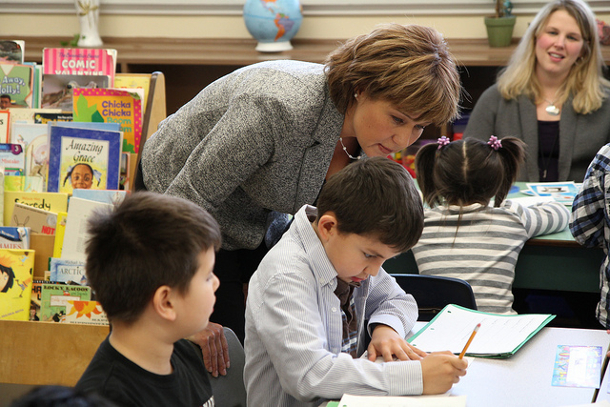The provincial government's decision to fund school districts based on the number of students isn't working, according to a growing number of critics.
Since 2002, per-pupil funding has comprised the bulk of operations funding for school districts each year.
But the BC School Trustees' Association and parent groups like the BC Confederation of Parent Advisory Councils and Parent Advocacy Network are calling on the government to re-examine the per-pupil funding formula.
While supplementary grants are provided to adjust for factors like the number of students learning English or with special needs, most funding is based on how many students show up for schools in September.
That formula is out of touch with the real world, say critics.
If a school falls from 200 to 185 students, the district faces a funding cut. But the cost of utilities, salaries and benefits, textbooks and supplies doesn't change.*
"And that kind of led us to the things that have happened this year with potential school closures," said BC School Trustees' Association president Teresa Rezansoff. About half of the 22 schools threatened with closure this year have shut their doors.
Funding formula an election issue for PACs
John Bird has only been president of the BC Confederation of Parent Advisory Councils for two months, but he's already seeking big funding formula changes.
"It has to be recreated from scratch," he said, adding that the confederation wants to work with government and other stakeholders on a review of both the formula and funding levels. The parents' group wants to make public education funding an issue in next May's provincial election.
Bird said districts have to spend money on their fixed costs -- salaries and benefits, utilities, maintenance.
So when school boards face deficits, it's "student services" -- everything from classroom services to supports for students who don't fit funded special needs categories to classroom resources -- that get cut first.
"What we would like to see is [the province] do some proper work analyzing what the resource and support needs of all our kids are, and then protect that portion of the funding," said Bird. "Look at their passions, their drives, their needs, their supports -- make sure the resources are there for them to have the best education that they can, then worry about the rest. We want the kids put up front, and right now they tend to be at the end."
Vancouver parent Jen Stewart, a member of both the Parent Advocacy Network and Families Against Cuts to Education BC, says both organizations have spent the last year calling for another Royal Commission on education to analyze both the formula and funding levels. The last Royal Commission was in 1988.
Stewart said the problem is not just the funding formula, but "unpredictable" funding which the government announces on an annual basis.
"You can't plan if you don't know from year to year how much money you have," she said. "Even if [districts] do know how many students they'll have, they don't know how much money they're getting because it all depends on the arbitrary amount the government decides to give to education in the budget in the spring."
Premier acknowledges funding formula not working
Parents aren't alone. MLAs on the Select Standing Committee on Finance and Government Services included "review the Ministry of Education funding formula for programs and services" in its 2016 budget recommendations.
Even the education ministry and premier's office indirectly acknowledge the formula isn't working. When half of B.C.'s 60 districts reported budget deficits for the 2016/17 school year, the province responded by returning the $25 million districts had been required to cut from their administrative budgets.
And when that wasn't enough to save some rural schools, the government created a Rural Education Enhancement Fund to keep schools open for the next year. Seven schools won a reprieve.
In an emailed statement, a spokesperson for the Ministry of Education said the province was investing a "record $5.1 billion" into education this year. As for ensuring that rural schools stay open despite population drops, the ministry has a plan.
"Recently appointed parliamentary secretary for rural education Linda Larson will conduct a comprehensive study of rural education funding and unique factors that may not be considered at present," the spokesperson wrote.
But Rezansoff says the issue is not just school closures. Even when schools are saved, students are still affected by years of cuts to programs, staffing and other measures that districts take to keep schools open.
Rezansoff says the funding formula needs to allow districts to respond to student needs.
"There needs to be some kind of blending, with the recognition that it's not about the number of students we have and it's not just about the building," she said. "It's about having a school in a community and it's about ensuring that students have equitable access to educational resources and experience."
"The experience of a student in an urban district should be pretty close to the experience for a student in a rural district."
'School funding reflects government's values'
But what should funding be based on if not student enrolment? Per-student funding has been the norm in B.C. for at least a quarter century, and former New Democrat Party deputy minister of education Charles Ungerleider says if there's a better way to fund schools, he hasn't heard of it.
"The funding formula is simply an allocation formula that doles out whatever the quantum of money is that the government decides it's going to devote to education to the various school boards," said Ungerleider, now a sociology of education professor at the University of British Columbia.
A better question, he says, is whether current funding is enough to cover the basic education program the government has to provide under the School Act. That doesn't include "extras" like band and string programs, automotive shop or photography electives, he added.
Rezansoff acknowledges that protecting basic education is critical, but adds those "extras" provide students a "richness of experience" that shouldn't be dismissed. Nor should rural districts be forced to close their schools due to declining population when there aren't schools within a "reasonable distance" to take those student, she added.
Rezansoff, a trustee in the Boundary School District since 1999, would like to see a return to a formula that blends the former approach of allocating funding per school with one that includes funding per student, while recognizing the importance of community schools to rural areas.*
But Ungerleider says the previous per building funding formula that Rezansoff's referring to, which Rezansoff's predecessor Gordon Comeau wanted changed because of "inequities," was based on per pupil funding. But it also had targeted funding for special needs, Aboriginal, students learning and English and other programming that had to be spent in those areas.
While still providing extra funding for those students, the Liberal government removed the restrictions dictating how boards spent that money in 2002. Ungerleider doesn't consider it a different funding formula, just a reflection of different priorities than the previous NDP government.
"When a government says no or yes about something, they're articulating their value position," he said. "And if people don't like that value position, what they do is they vote them out of office."
*Story clarified July 7 at 12 p.m. ![]()
Read more: Education, BC Politics
















Tyee Commenting Guidelines
Comments that violate guidelines risk being deleted, and violations may result in a temporary or permanent user ban. Maintain the spirit of good conversation to stay in the discussion.
*Please note The Tyee is not a forum for spreading misinformation about COVID-19, denying its existence or minimizing its risk to public health.
Do:
Do not: